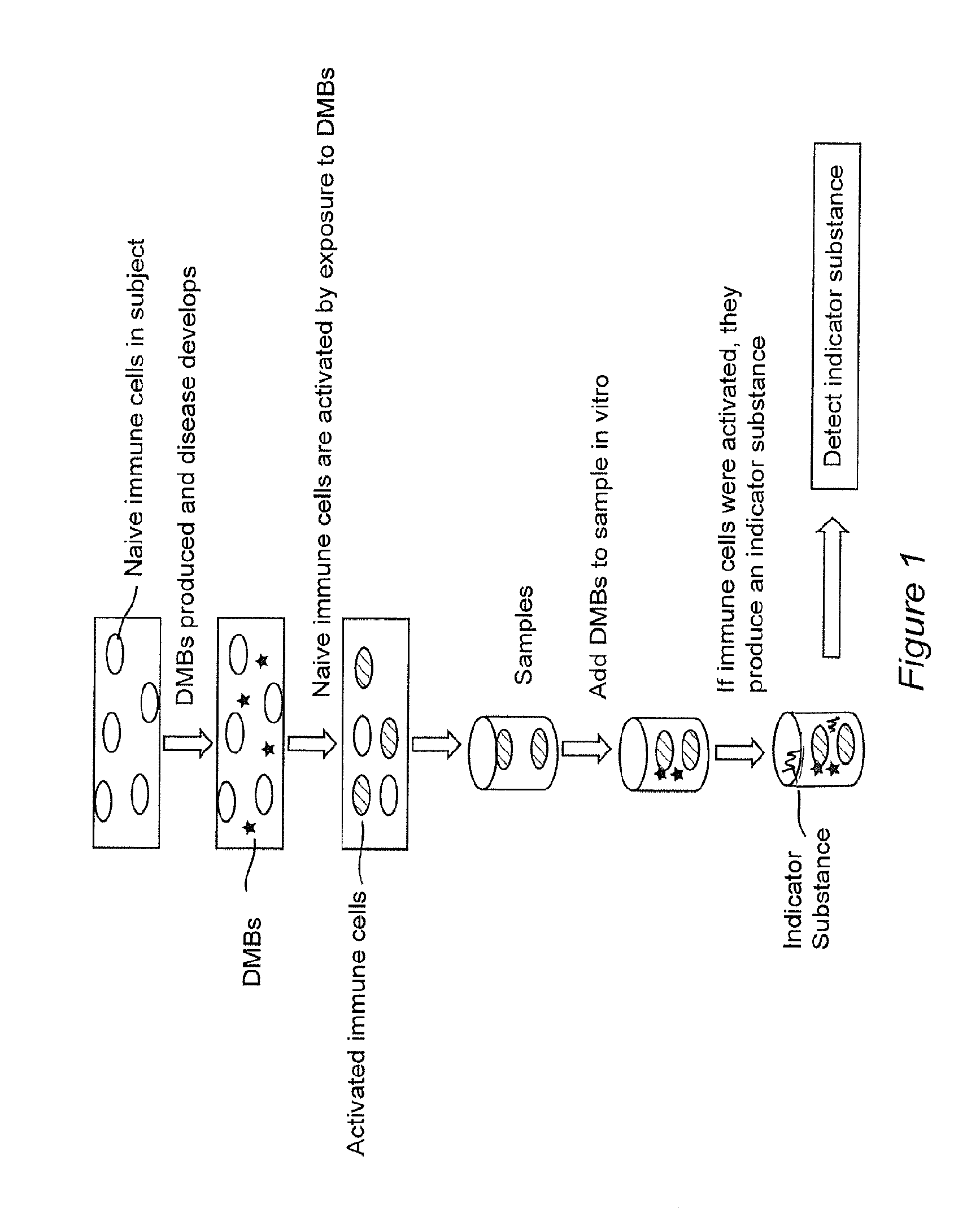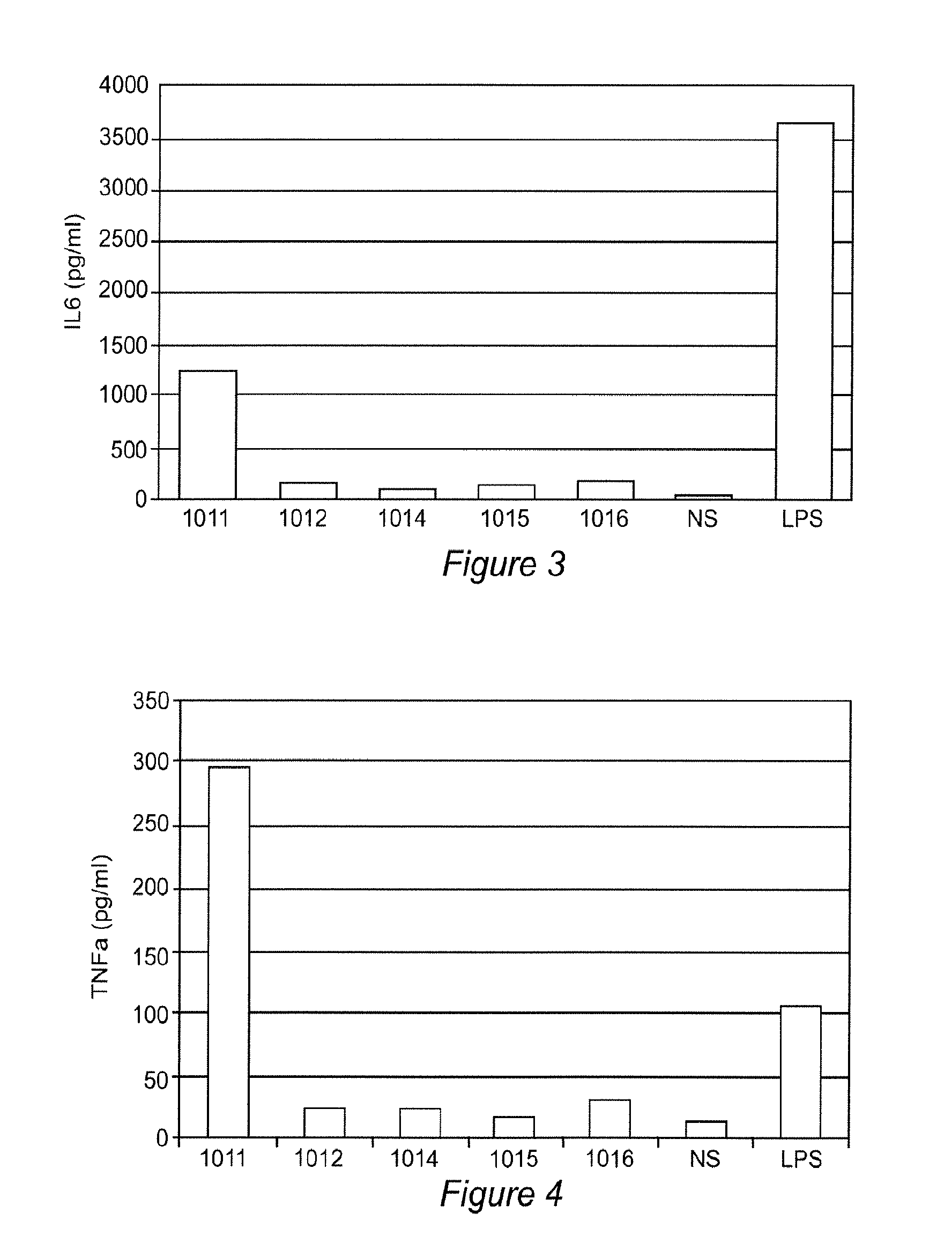Methods for diagnosing and monitoring diseases or conditions using disease modified biomolecules and measurement of a functional immune response
a technology of disease modification and immunomodulatory response, applied in the direction of antibody medical ingredients, instruments, material analysis, etc., can solve the problem of increasing the amount of indicator substances detected, and achieve the effect of reducing the immune respons
- Summary
- Abstract
- Description
- Claims
- Application Information
AI Technical Summary
Benefits of technology
Problems solved by technology
Method used
Image
Examples
example 1
DMB Specific Functional Immune Response Assay for Diagnosis and Prognosis of Rheumatoid Arthritis (RA)
[0066]Autoimmune diseases generally occur as a result of malfunctions in the normal human immune system. A healthy immune system helps protect the body from harmful substances such as bacteria, viruses, toxins, cancer cells, etc. In autoimmune diseases, the immune system apparently cannot tell the difference between antigens associated with these harmful foreign entities and the body's own tissues, and the immune cells respond by producing autoantibodies which attack the body's own tissues. More than 80 different autoimmune diseases have been identified and the treatment of such diseases is mainly through drugs to control (usually decrease) the immune response.
[0067]Autoantibodies have been successfully utilized in developing clinical diagnostic assays for autoimmune diseases. It has long been believed that autoantiboics are produced as a result of an aberrant immune response agains...
example 2
Design and Testing of Citrullinated Peptides for Detection of Rheumatoid Arthritis
Peptide Design and Synthesis
[0085]Peptide sequences were selected from human vimentin, fibrinogen (alpha or beta chain), filaggrin and alpha enolase. Citrullinated forms of these proteins are known to be reactive with autoantibodies from patients suffering from rheumatoid arthritis. A total of 16 peptides in citrullinated or non-citrullinated forms were chemically synthesized (Table 1). The purity of these synthesized was at least 95%.
[0086]In order to evaluate cellular stimulation responses for these peptides and thus identify citrullinated peptides for use in the practice of the invention, peptides were designed based on a) the protein source of the peptides; b) the number of citrullinated residues per peptide (which ranged from 0 to 3); and c) the distribution pattern of citrulline residues in each peptide.
TABLE 1DMB peptide sequences# ofPeptideProteincitrullinenamesourcesresiduesPeptide sequencesDM...
experiment 2
duction after PBMC Stimulation Using Individual Peptides from DMB 1011 to DMB 1016
[0090]Experimental setting: Peripheral blood mononuclear cells (PBMCs) were prepared from freshly collected blood using a Ficoll gradient method. The cellular stimulation assay was performed by incubating PBMCs with individual peptides DMB 1011 to DMB 1016. Approximately 300,000 to 500,000 PBMC cells were used for each stimulation assay in a cell culture AIM V serum free medium (Life Technologies) within a 96 well round bottom plate. Concentrations of TNFα and IL6 in culture supernatants were determined after 20 hrs incubation using the AlphaLisa® method.
[0091]Results: Peptide DMB 1011 has the same sequence of DMB 1001 but adds two amino acids (Gly-Gly) to its N terminal. The addition of two amino acids improved the peptide solubility in water. Significantly higher concentrations of IL6 (FIG. 3) and TNFα (FIG. 4) were detected in cultures stimulated by DMB 1011 but not those stimulated with other pepti...
PUM
| Property | Measurement | Unit |
|---|---|---|
| temperature | aaaaa | aaaaa |
| concentration | aaaaa | aaaaa |
| concentrations | aaaaa | aaaaa |
Abstract
Description
Claims
Application Information
 Login to View More
Login to View More - R&D
- Intellectual Property
- Life Sciences
- Materials
- Tech Scout
- Unparalleled Data Quality
- Higher Quality Content
- 60% Fewer Hallucinations
Browse by: Latest US Patents, China's latest patents, Technical Efficacy Thesaurus, Application Domain, Technology Topic, Popular Technical Reports.
© 2025 PatSnap. All rights reserved.Legal|Privacy policy|Modern Slavery Act Transparency Statement|Sitemap|About US| Contact US: help@patsnap.com



